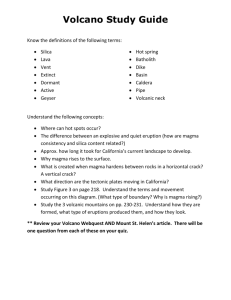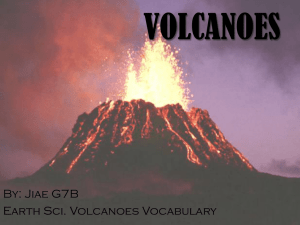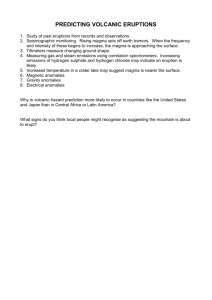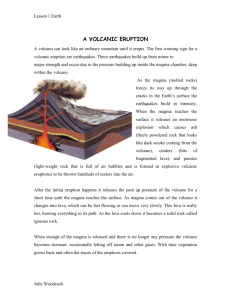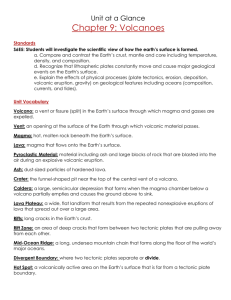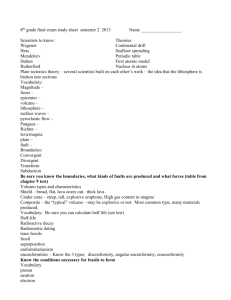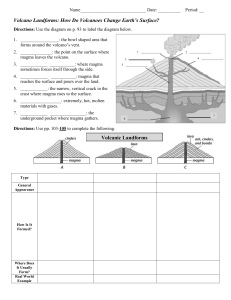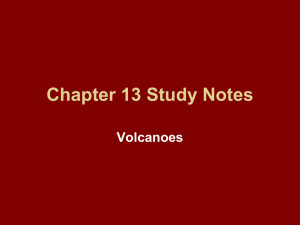Obtaining information about inside the earth.
advertisement
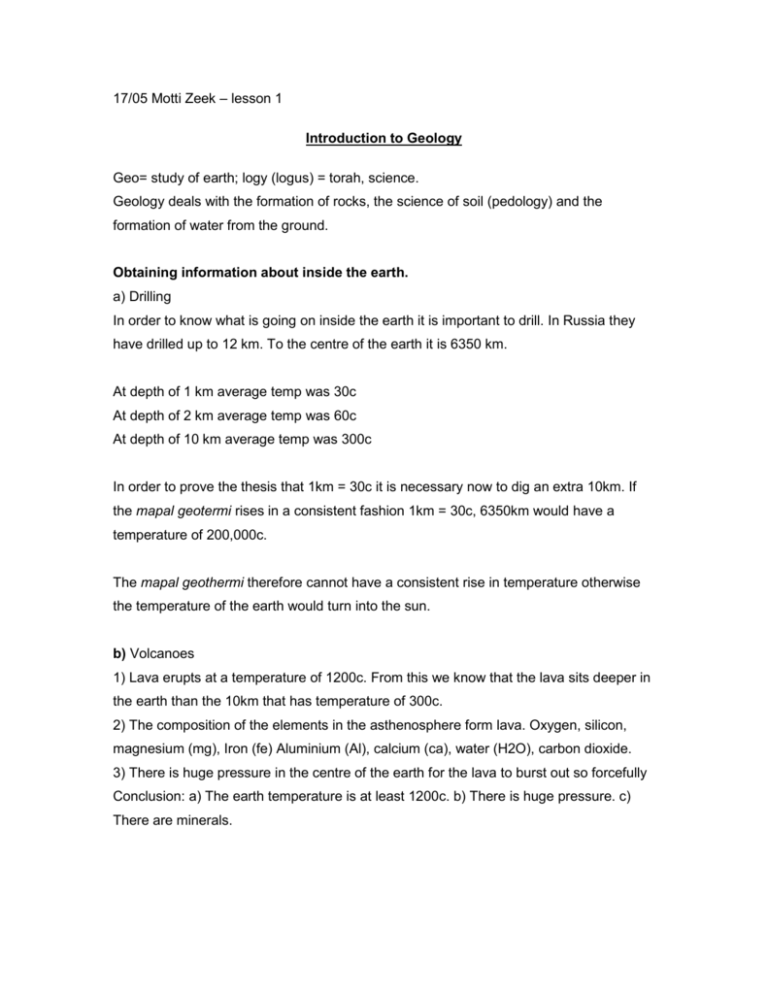
17/05 Motti Zeek – lesson 1 Introduction to Geology Geo= study of earth; logy (logus) = torah, science. Geology deals with the formation of rocks, the science of soil (pedology) and the formation of water from the ground. Obtaining information about inside the earth. a) Drilling In order to know what is going on inside the earth it is important to drill. In Russia they have drilled up to 12 km. To the centre of the earth it is 6350 km. At depth of 1 km average temp was 30c At depth of 2 km average temp was 60c At depth of 10 km average temp was 300c In order to prove the thesis that 1km = 30c it is necessary now to dig an extra 10km. If the mapal geotermi rises in a consistent fashion 1km = 30c, 6350km would have a temperature of 200,000c. The mapal geothermi therefore cannot have a consistent rise in temperature otherwise the temperature of the earth would turn into the sun. b) Volcanoes 1) Lava erupts at a temperature of 1200c. From this we know that the lava sits deeper in the earth than the 10km that has temperature of 300c. 2) The composition of the elements in the asthenosphere form lava. Oxygen, silicon, magnesium (mg), Iron (fe) Aluminium (Al), calcium (ca), water (H2O), carbon dioxide. 3) There is huge pressure in the centre of the earth for the lava to burst out so forcefully Conclusion: a) The earth temperature is at least 1200c. b) There is huge pressure. c) There are minerals. The reasons for the heat inside the earth a) the sun does not cause the heat because soil that is only a few centimetres deep is cool as opposed to top level concrete which heats up b) pressure c) Breakdown of radioactive material in the Ga-lin (pit-lowest part) of the earth. The break down of the radioactive material in the elements releases energy and heats the asthenosphere where it becomes magma. Radioactivity in the Gal-in When one element has been broken down it turns into a different one. 1 kg of radioactive uranium broken down becomes 1/2 kg lead (4.5 billion years to do) The time that it takes for radioactive material to turn into non-radioactive material is called Zeman Machazit HaHayim. Different elements take different times and have a different Zeman Machazit HaHayim. Rocks and minerals The magma is hot and makes cracks in the lithosphere. The magma rises to this and makes the magma chamber. The surrounding temperature of the lithosphere is lower than that of the Magma chamber, the heat moves to where it is cooler and over the course of time the magma chamber cools to the same temperature as the surrounding rocks. When this happens different elements are attracted to each other and mix with each other and turn into minerals – a crystallisation process. Minerals then stick to one another forming rocks. A rock is a natural accumulation of minerals. E.g. Silicon (Si) cools and mixes with oxygen (O2) Si + O2 = Sio2 (Quartz) Si = O2 + Al = Feldspar Si + O2 + Fe = Mica Quartz + Feldspar + Mica = Granite. Igneous rocks – Salai Yesod The source of all igneous rocks and minerals is in the magma chamber. Crystallisation (hitgabshoot) happens when the chamber cools and the minerals are formed, causing the minerals to be attracted to one another in the magma chamber. Granite is made inside planet earth and is exposed as a result of weathering process and internal process The formation of volcanic (Peretz) Igneous rocks- Eruption of volcanoes Magma is molten rock that has a temperature of at least 1200c. Magma is all the elements plus some gas forms of oxygen and carbon dioxide. It is less dense than the surrounding rock that causes it to rise. When magma reaches the surface and explodes into the air, all the gases leave it, making holes in the rock and turning it to hard lava. Formation of volcanoes. Volcanoes are defined as a "geological landform, consisting of fissure in the earth's crust, above which a cone of volcanic material has accumulated". The earth is made up of plates that are in a constant state of motion. Usually volcanoes develop on the boundaries of these plates. The plates have two types of movement, convergent and divergent. Convergent movement is when the plates come together and divergent movement is when they separate. A hot spot refers to an area on a plate that has been heated internally, from the mantle. A volcano can form in any one of these situations. It is not even uncommon for the majority of our volcanoes to begin on the ocean floor. The cone of a volcano is brought about by the build-up of materials (fragments, dust, lava) that is expelled from the center of the earth. Repetitive eruptions of lava and solid matter results in the formation of the walls (cone) of the volcano. The type of formation that develops depends on the type of eruption. The different types are caldera, cinder cones, shield volcanoes, composite volcanoes and strato-volcanos. Numerous bouts of volcanic activity are responsible for the sloping and peaked formations of our earth's surface. It has been estimated that over three quarters of our earth's surface was formed in this way . There are 3 states to a volcano Extinguished – Kaboo-ee 10,000 years didn’t erupt, wont ever erupt Dormant - Radoom – not defined clearly, not erupted for few 1000 years Active - Pe’il – has erupted over the last few hundred years Age of rocks according to last volcanic survey South Golan 4 million Mid Golan 2 million North Golan 1 Million The process of the formation of plutonic (tehom/plutonic) Igneous rocks As a result of the break down of radioactive materials the temperature at the core of the earth rises. The temperature raises the pressure and as a result the lithosphere in certain parts becomes solid. Hot magma pushes it’s way to the cracks creating magma chambers, the surrounding area is cooler than the magma and as a result the crystallization of the elements begins inside the magma chamber. Different minerals are formed and attracted to one another as the magma cools and as a result rocks are formed. One of the most common rocks is granite – whose 3 minerals are Feldspar Mica and quartz. i.e. a granite rock has formed inside the earth and as a result of inside pressure and external weathering (blaiya) granite is slowly exposed to the surface. 2 types of Igneous Rocks (Sal’ay Yesod) Volcanic Rock (sal’ay Peretz) (Broke out of the earth) Basalt Plutonic rock (Formed inside the earth) Granite Which rocks are in Israel? Timna and Eilat mountains are granite that have been eroded to see the mountains, Erosion (blaya) wears down the magma rock which has penetrated the crust of the earth and leaves the magma chamber leaving the surface exposed. The lower Galilee and Golan heights is the volcanic area with much basalt. Some basalt in Carmel and Ramon crater also the Horns of Hittin. The Golan Heights was once a basin (ka-ar) between Gilad and Hermon (chalk) mountain. The kiluach trickled out between these two mountains and filled the basin, hardened into basalt and formed the heights. The Golan is largely comprised of basalt i.e. Kiluach that cooled off. Boundaries of the Golan are between Yarmuch River and Sa’ar River. When walking on a mountainous region of granite, actually walking on the top of a magma chamber. Granite is the most common rock on the face of the earth. The weathering between the limestone and the basalt causes strong weathering and that’s how the rivers were formed. Sandstone is the breakdown of granite Lava = Magma minus gases Scoria = Large lava Tuff = Scoria less than 2mm Volcanic ash = Tuff in the air is. It also has holes in it like the scoria, but is too small to see. It is the pressure inside the magma chamber that makes the volcano erupt. Kiluach – the magma oozing out slowly, this lava takes longer for the gasses to leave Basalt The lava that reaches the Earth's surface through kiluach, and hardens into basalt volcanic igneous rock. It is the same as lava but basalt does not have holes. Dyke = magma that hardened vertically within the crack/fissure (sedek) but didn’t break out. One is in Shmurat Ramon. Sil - magma that hardened horizontally within the crack/fissure (sedek) but didn’t break out. Caldera - A vast depression at the top of a volcanic cone, formed when an eruption substantially empties the reservoir of magma beneath the cone's summit. Eventually the summit collapses inward, creating a caldera. A caldera may be more than 15 kilometers in diameter and more than 1000 meters deep. Pressure can cause it to collapse or explode when the neck of the volcano becomes blocked. Birkat Ram is caldera. Har Peres is large volcano with a small mouth. A sign of an explosion of a volcano is that the whole area has been raised. Nubo-Arabian shield HaMasiv HaArvu Nubo – A massive magma chamber of crystallized igneous and metamorphic rocks that stretches from Saudi Arabia until Egypt.
